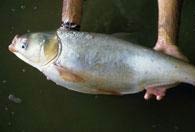This is the VOA Special English Agriculture Report.
Last week our subject was illegal fishing. Now we report on two cases where fish are both the victims and the offenders.
The first involves two kinds of Asiancarp, bighead and silver. They can grow more than a meter long and weigh up to 45 kilos. They eat huge amounts of plankton that other fish need to survive. Silver carp can also jump high and hit boaters.

Asian carp were brought to the United States in the 1970s as a solution. They were imported to eat algae and other microscopic organisms. They were put to work as cleaners at fish farms along the Mississippi River and in wastewater treatment systems.
But now the fish are moving north toward the Great Lakes. They are making their way up a system built years ago to link the Mississippi to Lake Michigan.
The dangers of an invasion are environmental and economic. The destructive carp could spread within the Great Lakes and threaten fishing and trade.
The Army Corps of Engineers has put an electric fence in the Chicago Sanitary and Ship Canal. The underwater barrier is meant to shock the carp into turning back. Only one Asian carp was found among many thousands of fish killed with poison while part of the fence was being serviced.
The barrier, however, may not be enough to protect the Great Lakes. There are calls in Congress for emergency action. Officials could close shipping connections between Lake Michigan and the upper Mississippi River system. But there are no decisions yet.
So that is the situation in the Midwest. Farther west, the problem is with common carp. Officials in Utah want to remove around three-fourths of the carp from Utah Lake. The lake, near the city of Provo, is the largest natural body of freshwater in the state.
The state wants to remove millions of carp to protect an endangered species native only to Utah Lake, it's called the June sucker fish. The carp eat plants that the suckers use as hiding places.
Carp were first put into the lake in the 1880s as a food source. Now there are so many, experts say up to 20 metric tons a day could be removed with nets over a period of several years.
But officials are fishing for ideas about what to do with all those fish, which could get pretty smelly. Ideas include using them to fill land or making them into liquid fertilizer or letting people eat them.
You can share your own suggestions at voaspecialenglish.com.
And that's the VOA Special English Agriculture Report, written by Jerilyn Watson. I'm Jim Tedder.
carp: an edible freshwater fish of Europe and Asia that is frequently bred in ponds and lakes 鲤鱼
plankton: the collection of small or microscopic organisms, including algae and protozoans, that float or drift in great numbers in fresh or salt water, especially at or near the surface, and serve as food for fish and other larger organisms 浮游生物
alga: (pl.algae)any of various chiefly aquatic, eukaryotic, photosynthetic organisms, ranging in size from single-celled forms to the giant kelp. Algae were once considered to be plants but are now classified separately because they lack true roots, stems, leaves, and embryos 藻类
Related stories:
An international treaty targets fishing abuses
Quotas cut as scientists warn that southern bluefin tuna stocks close to collapse
Study finds some ocean fisheries are recovering
Oceans becoming more acidic, endangering sea life
(来源:VOA 编辑:陈丹妮)